Emerging as one of central Europe’s most adored city destinations, Budapest is not short of fans. The capital city of Hungary has blossomed into an immensely popular city break destination, and it’s no wonder why. Budapest caters to visitors of all interests, whether they are looking for nightlife, culture, or Old-World grandeur.
So where do you start with a trip to Budapest? Most visits to the city last two or three days, which isn’t a huge amount of time given all that there is to see. To really make the most of your time, it’s best to follow a detailed Budapest itinerary, like this one. You’ll learn about all the best places to visit in Budapest, ensuring you don’t feel like you’ve missed anything, and by the end of this guide, you’ll know what to do in Budapest in 3 days to be fully prepared for what is sure to be a great trip.
Best Time to Visit Budapest
Timing is everything with a destination like Budapest since when you visit can have a major impact on your trip. Factors like weather and tourist numbers can make or break a visit, so it pays to keep them in mind when you’re planning. Like most trips, finding the right time for you involves a trade-off between these considerations.
Generally speaking, the best time to visit Budapest is in the shoulder months of March to May and September to November. During these months, you can expect pleasant weather suitable for sightseeing, while crowds of tourists won’t be at their worst. It’s also the best time to visit on a budget since rates are lower than in high season.
It’s in the summer months of June through August that Budapest is as its busiest, thanks to the warm weather and events like the famous Sziget Festival. The lead up to Christmas isn’t much better in terms of crowds, as Budapest is widely regarded as having one of the best Christmas markets in Europe. Of course, you can expect winters in Budapest to be cold and snowy, limiting how long you’ll want to be outside. If you decide to visit at either of these busy times, it’s best to book well in advance as rates are guaranteed to rise.
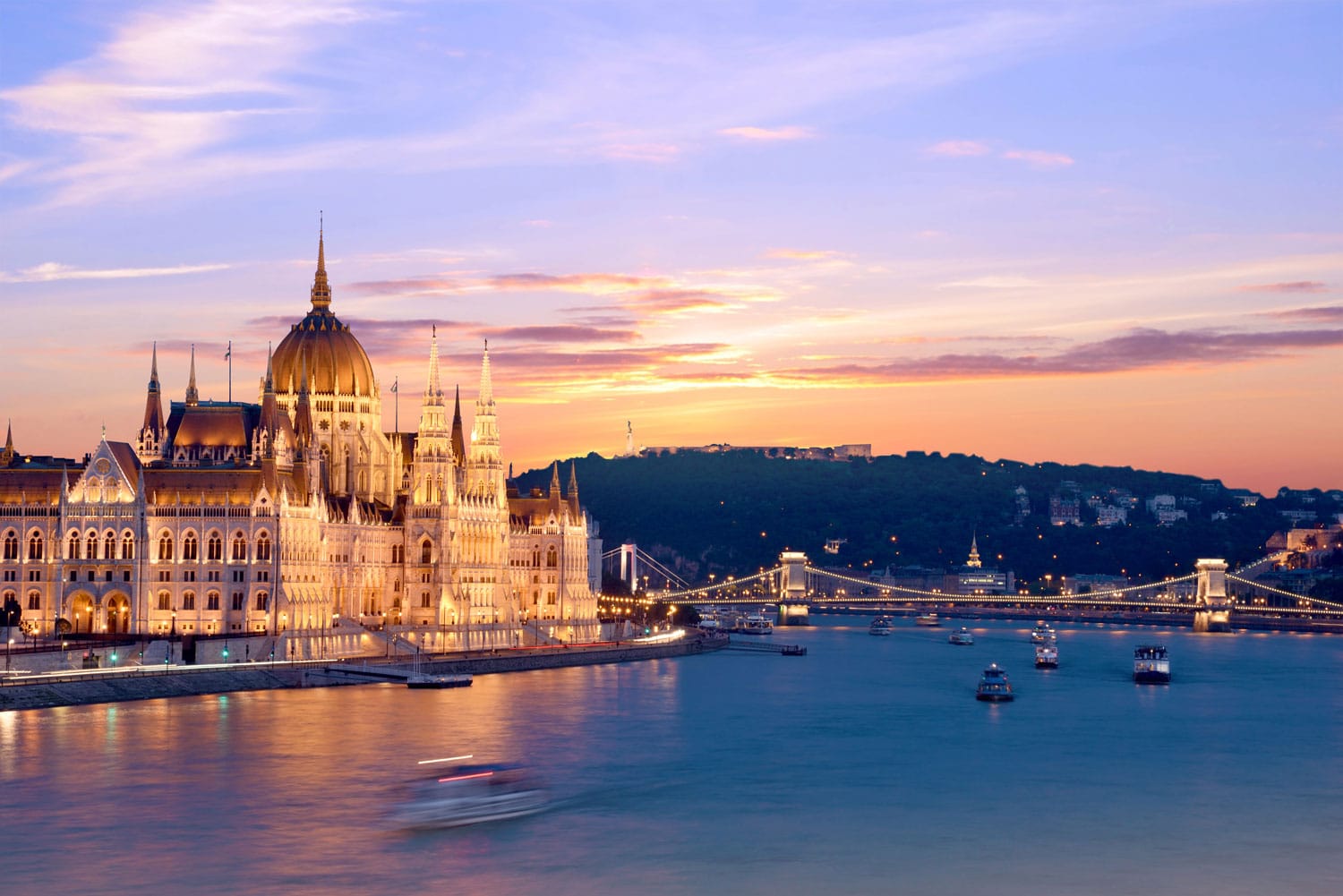
How to Get Around Budapest
While visiting Budapest, you’re going to spend a fair amount of time getting from one attraction to the next. You may not realize just how large Budapest is until you’re there, but it’s safe to say you’ll want to know what alternatives there are to walking. While we have organized this Budapest itinerary to be as geographically logical as possible, it’s always useful to understand local public transport networks.
In Budapest, public transport consists of metro, trams, buses, and suburban rail. Because of their coverage, you’re most likely to use the city’s metro and tram services. All the different forms of transport share the same ticketing system, with a single ticket costing HUF 350, roughly $1.10. Tickets can be bought at metro stations, tram stations, and street kiosks, or from bus drivers at a higher price.
To travel from the city center to Budapest airport, you have a few options. Probably the easiest is the 100E airport shuttle bus that runs from the city center every 20 minutes, requiring a special ticket costing HUF 900. Alternatively, you can take a combination of the 200E airport shuttle to the nearest metro stop. Normally, you’d take the M3 metro from there, but long-term interventions mean that replacement buses are in effect. For this option, you’ll need a transfer ticket, which is HUF 530. Finally, there’s the option of a private shuttle, which typically costs around €25, or the shared Airport shuttle for around €10.
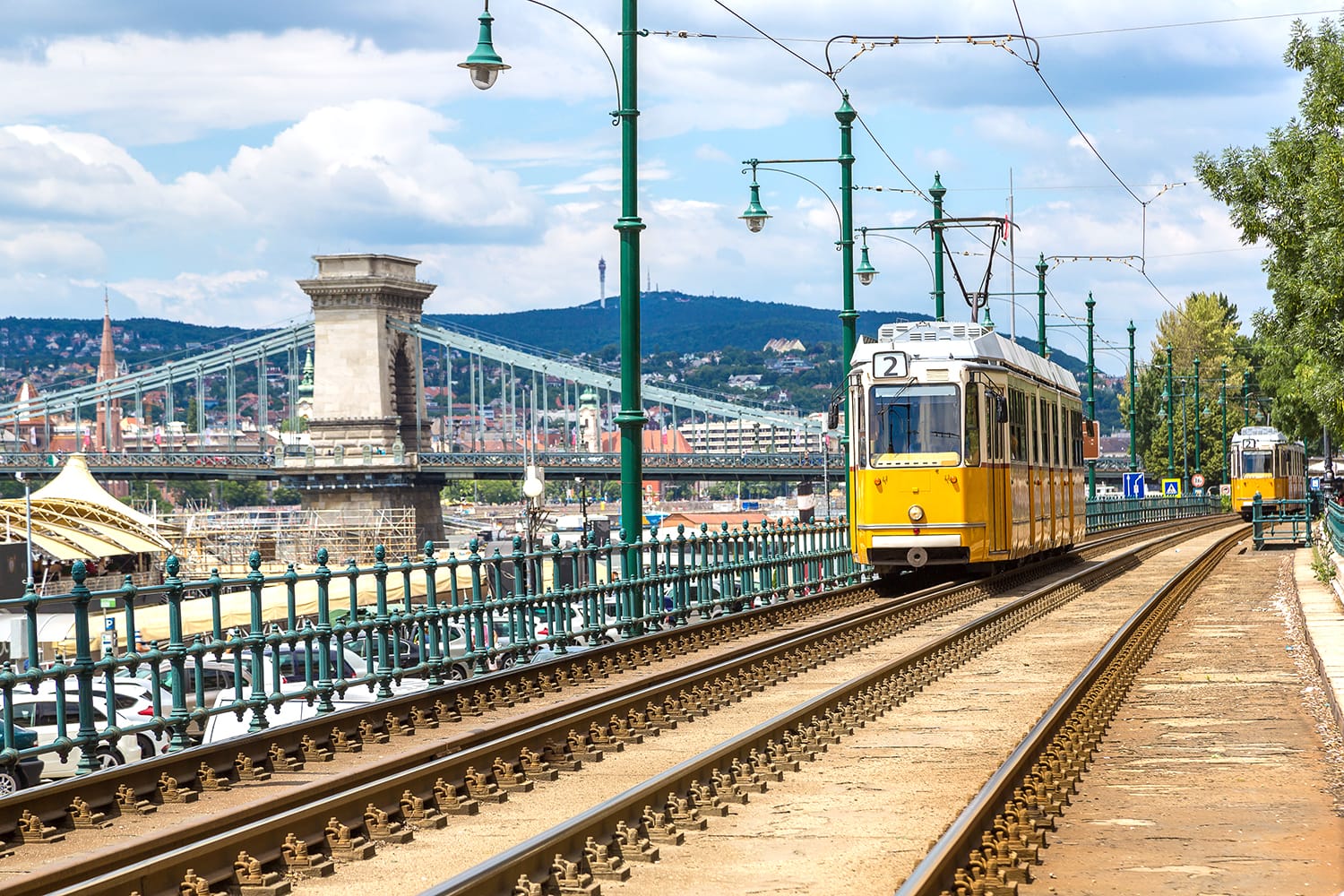
Where to Stay in Budapest
Whenever you visit a new city, one of the biggest questions that pops up is where to stay. To work it out, you need to take into consideration things like type of accommodation, budget, facilities, and location.
To find the best places to stay in Budapest, it’s important to understand that Budapest is divided by the Danube River. In the past, Budapest was actually two cities: Buda on the west and Pest on the east. You’ll find accommodation on both sides of the river, although there’s much more choice on the Pest side. Which side of the Danube isn’t really important; instead focus on proximity to the river and the city center, as well as to nearby public transport.
For a truly pampered stay of unparalleled comfort, look no further than the Kempinski Hotel Corvinus Budapest. This five-star hotel, perfectly located in the city center, boasts rooms with elegant welcoming décor, as well as multiple dining and relaxation options.
Balancing comfort and affordability, Leonardo Boutique Hotel Budapest M-Square is a stylish midrange pick. Recently renovated and with little touches like coffee- and tea-making facilities, this four-star hotel in the city center will be a welcome respite at the end of a long day of sightseeing.
Another great option to consider for affordable accommodation and apartments is Airbnb. For recommendations, check out our list of the best Airbnbs in Budpest.
For a perfectly located hostel with a view, be sure to stay at Pal’s Hostel in the heart of Budapest. This hostel boasts helpful staff and affordable rates, with both dorm beds and private rooms available. To see more good hostels in Budapest, see our dedicated Budapest hostel guide.
For more accommodation options in Budapest check out Booking.com. The company continuously offers the best rates and its custom service is on point.
The Perfect 3-Day Budapest Itinerary
With no shortage of attractions and activities to keep you occupied, filling two or more days in Budapest won’t be hard. This guide will take you through all the best things to do in Budapest so that you don’t miss out. To see the best of Budapest, you’ll need to explore both halves of the city, Buda and Pest. It’s also important that you allow a little time to discover some of the other great destinations just a short trip from the city.
However, before we get to our Budapest itinerary, we just wanted to remind you to purchase travel insurance. You never know what will happen and, trust us, you do not want to get stuck with thousands of dollars in medical bills. As a wise man once said, “If you can’t afford travel insurance, you can’t afford to travel.” So don’t leave home without it.
SafetyWing offers travel insurance for only about $10 a week, making it a no-brainer to get. You can get a quick, non-binding quote below:

SafetyWing is, of course, not the only option available. Two other popular alternatives are World Nomads and Heymondo.
With that important subject covered, we can now dive into the good stuff – our Budapest travel itinerary. Below is all you’ll need to know to have a great time experiencing Budapest in 3 days.
Budapest Itinerary: Day 1
We’ll start our visit to Budapest by first seeing the sights on the Buda side of the city before heading down to the Danube. That way, you’ll get to experience some of the most iconic attractions right off the bat.
Buda Castle
Dominating the western bank of the Danube River, Buda Castle is a great place to start your visit. The historic castle complex covers a significant area, meaning you can end up spending quite a lot of time exploring what’s known as the Castle District. Here you’ll come across plenty of fountains, statues, and fortifications, the last of which have some really great views over the city.
One of the district’s main landmarks is the expansive Baroque Royal Palace, which dates from the 18th century. No longer associated with any royal family, today the palace hosts the Hungarian National Gallery and the Budapest History Museum. In the Hungarian National Gallery, you’ll find exhibits on Hungarian art from the last two centuries, while the Budapest History Museum looks at the city’s long history.
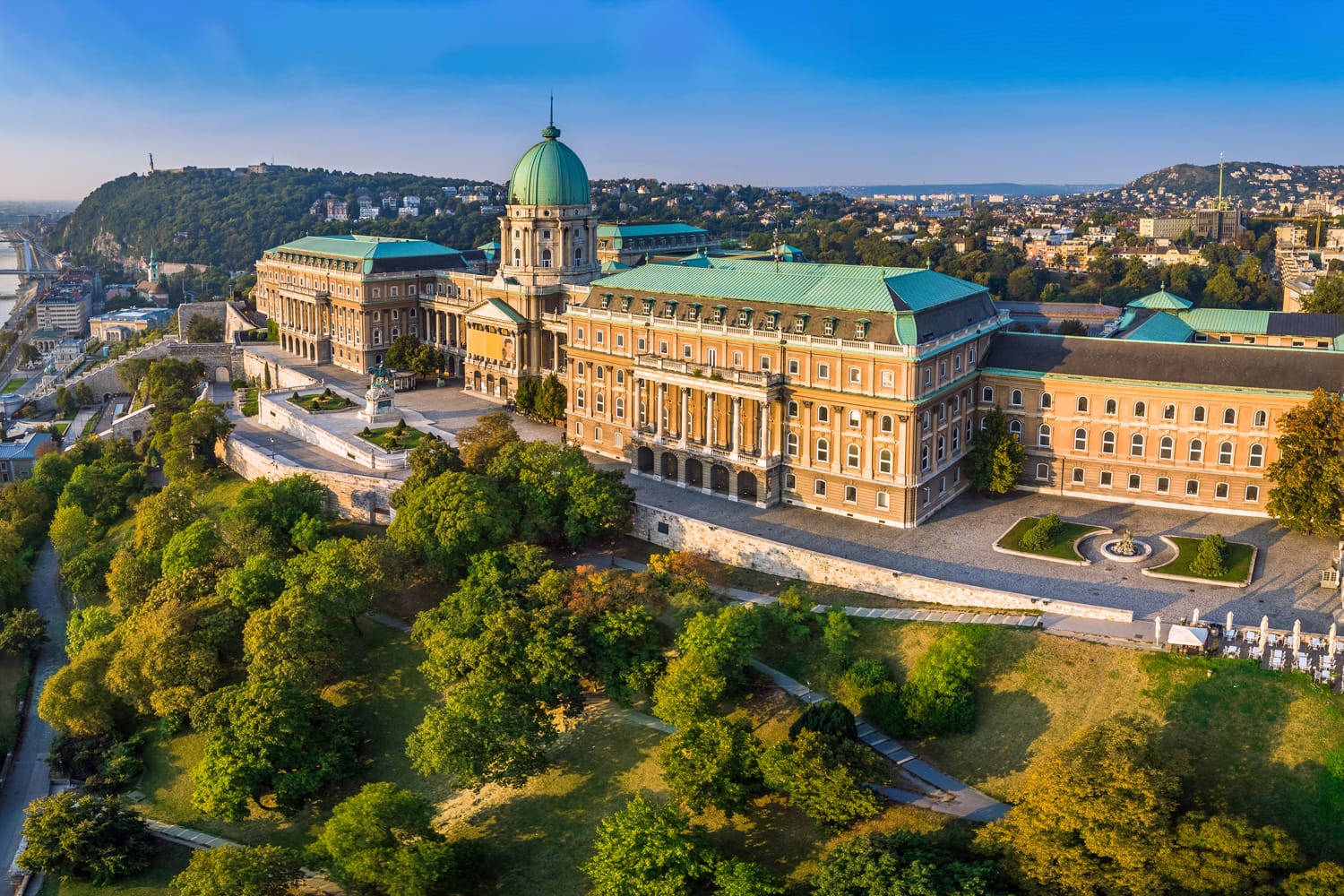
Fisherman’s Bastion
Easily one of the most popular places to visit in Budapest, the iconic Fisherman’s Bastion is next up. Found near the northern end of the Castle District, Fisherman’s Bastion is where most visitors go for their panoramic view of the city. What makes it special is that its terrace is decorated with turrets and archways that make it look like it belongs in a fairy tale. Expect to see plenty of people taking photos on its stairs and through its arches.
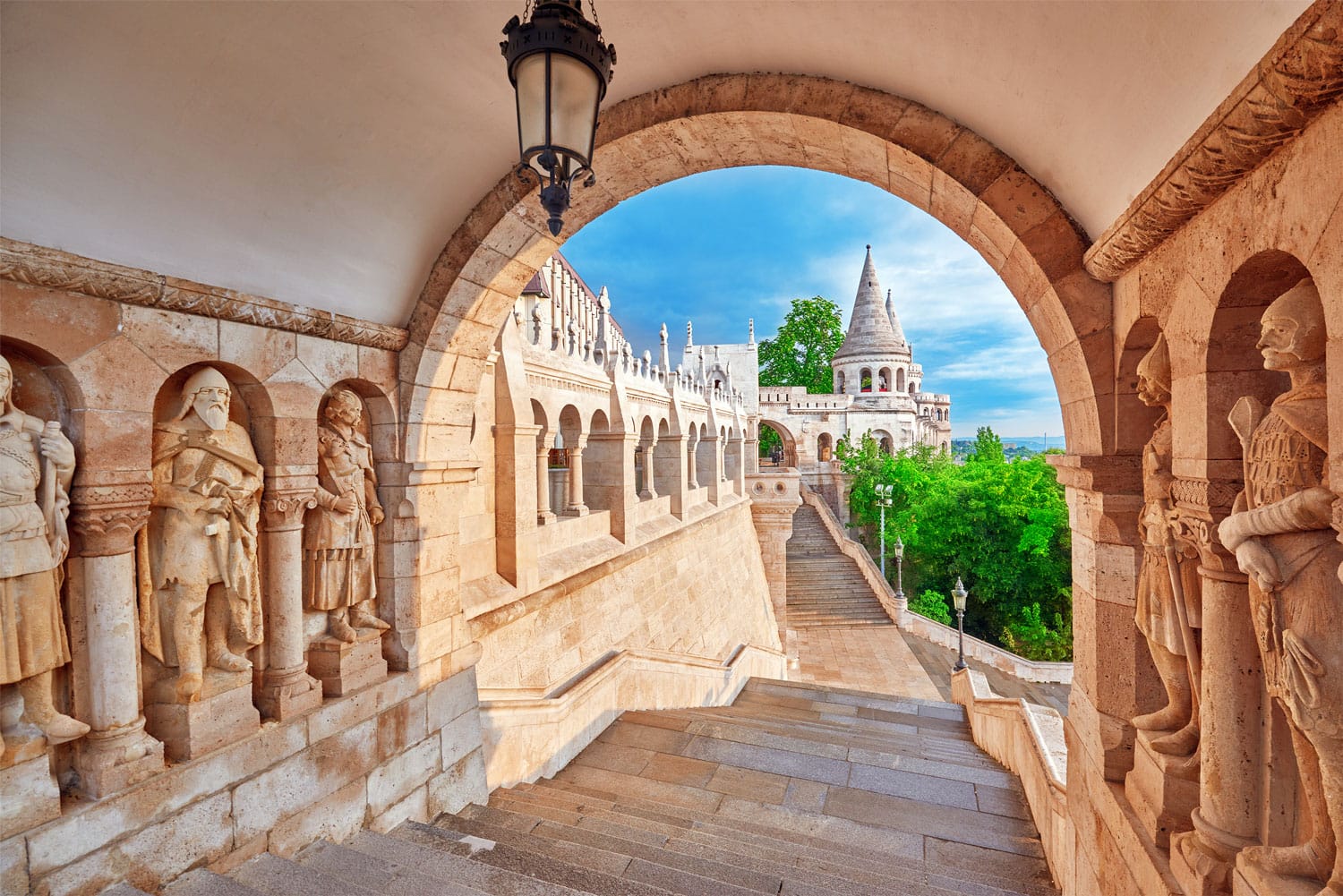
Matthias Church
Just opposite the Fisherman’s Bastion stands one of Budapest’s most beautiful churches, the Matthias Church. Founded in 1015 by the first king of Hungary, the church is a special sight both inside and out. From the outside, you can appreciate its elaborate Gothic architecture and pretty tiled roof. Head inside and it steps up a notch, with glamorous vaulted ceilings, a museum boasting religious relics, and replicas of the Hungarian crown jewels.
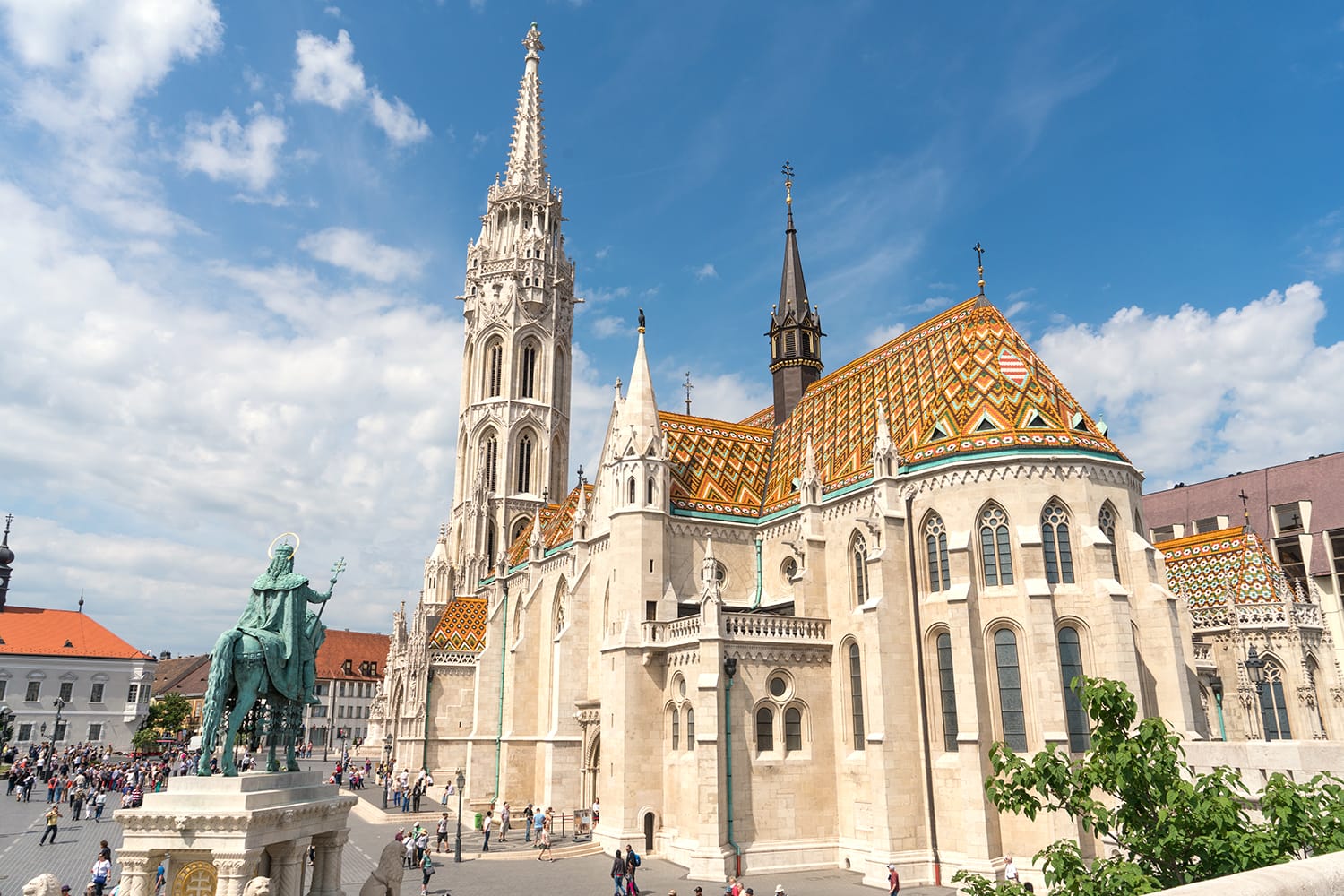
Gellert Hill
Leaving Buda Castle but sticking to the same side of the river, head for Gellert Hill just to the south. A network of walking paths lead you through peaceful parkland to the historic citadel resting at the top of the hill. Once at the top, you can enjoy yet another lookout point, this time with a fresh vantage point of Budapest. This spot is quite popular come sunset, so you may want to consider returning another evening.
Heading back down the hill, make sure you visit the Gellert Hill Cave Church, found in a network of caves under the hill. The church was constructed in the 1920s by a group of Pauline monks inspired by similar rock constructions during a pilgrimage in Lourdes, France. The cave church is easy enough to find thanks to the turrets decorating the monastery, although the actual entrance is tucked around the side.
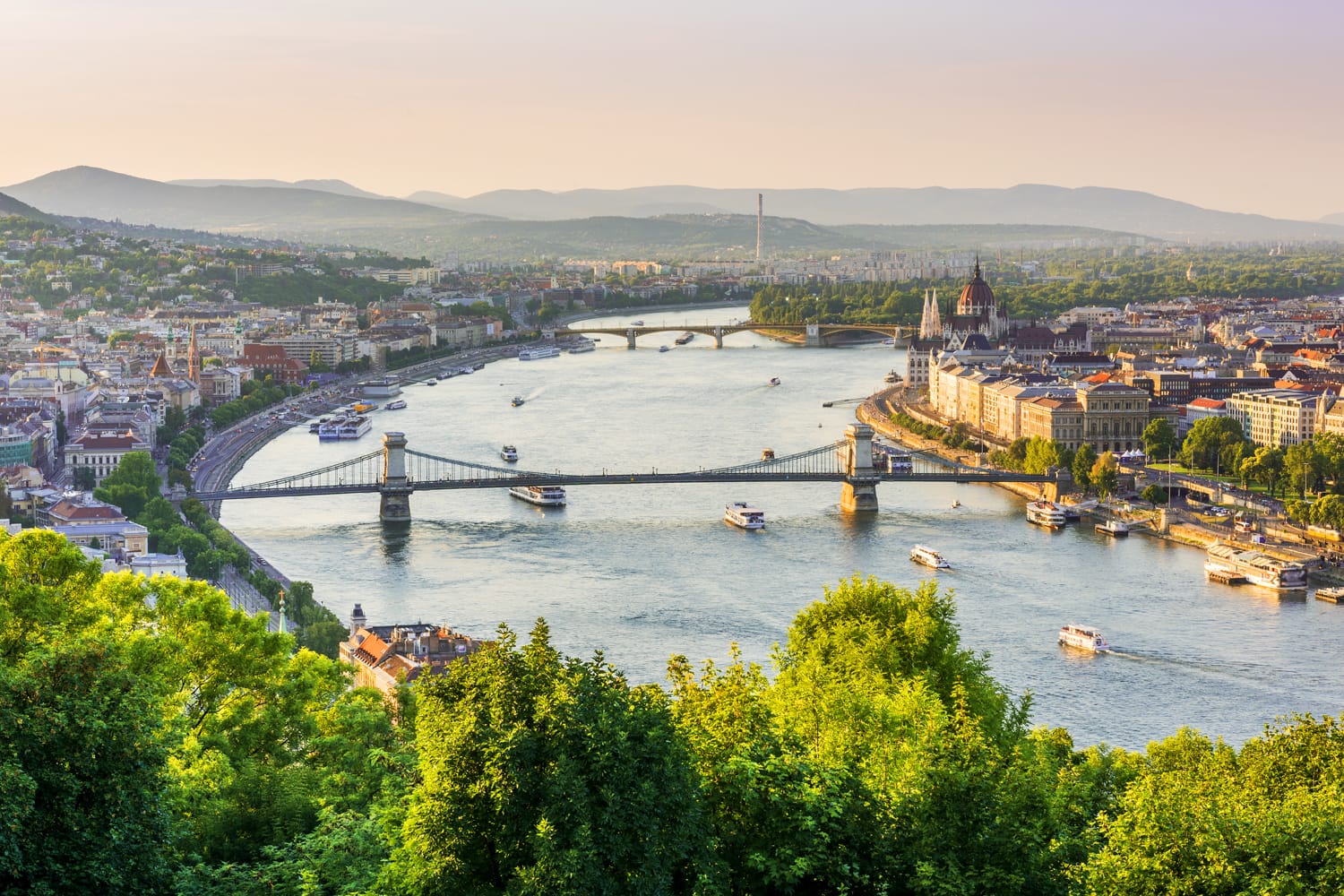
Central Market Hall
Markets are always a great place to get a feel for local life in a city, and the Central Market Hall of Budapest is no exception. Located on the opposite bank of the Danube from Gellert Hill, Central Market Hall is Budapest’s largest market and is a place not to miss. Across its two floors, you’ll find a broad range of items for sale, particularly fresh produce and souvenirs. But the Central Market is ideal for people-watching, too, especially inside its pretty neo-Gothic hall that dates from the late 19th century.
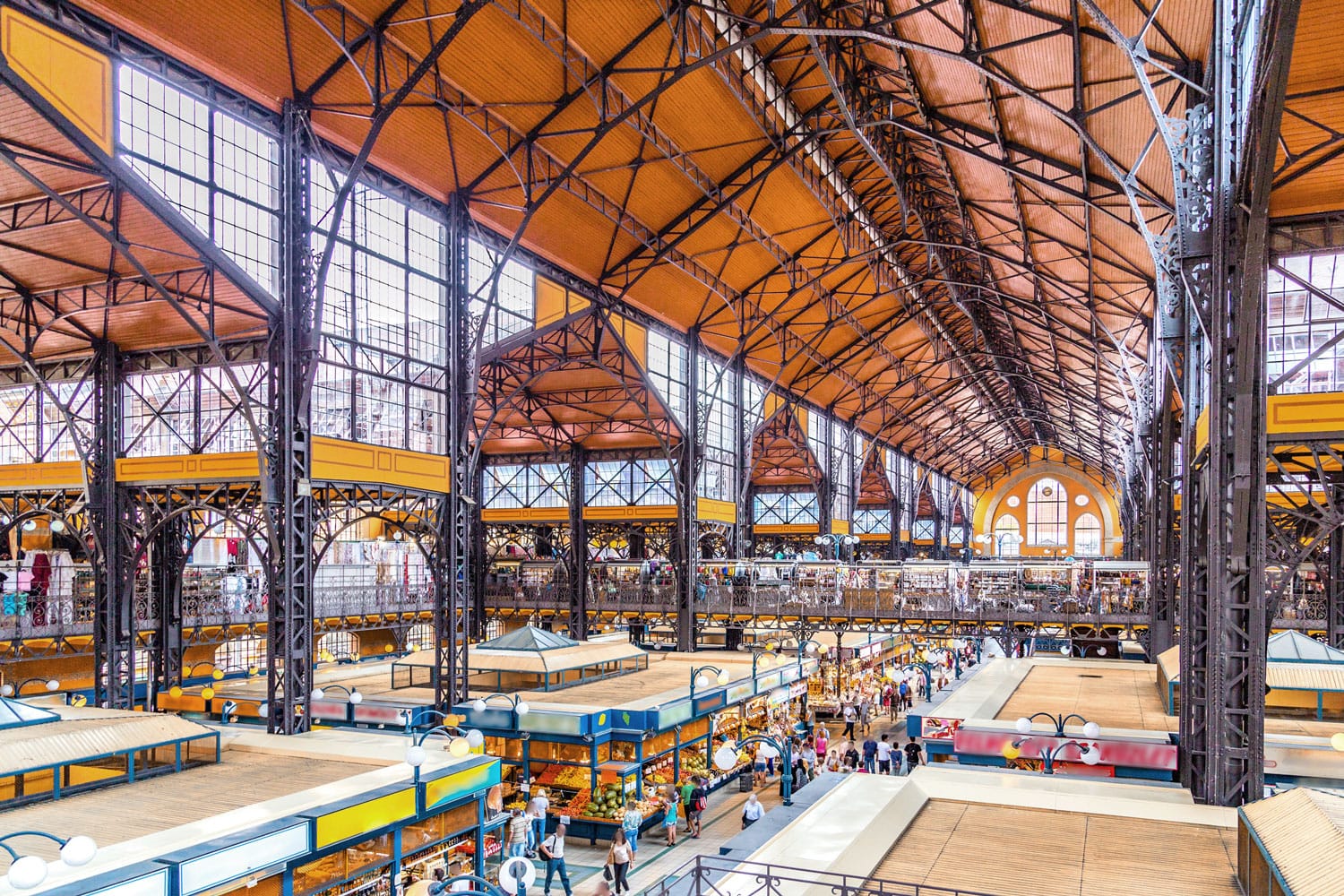
Hungarian Parliament
Resting along the banks of the Danube, the Hungarian Parliament Building is another of the city’s most recognizable landmarks. Having admired it from afar earlier in the day, it’s time to see this magnificent building up close. The Parliament of Budapest impresses thanks to its extravagant neo-Gothic style and enormous size. It’s the third-largest parliament building in the world, something that you really can’t appreciate until it towers in front of you.
The best way to fully appreciate this architectural marvel is on one of Budapest’s best tours, as you’re guided around the parliament’s interior. You’ll not only see the grand design of its interior and learn the building’s history but also have the chance to see the actual Hungarian Crown Jewels and the Hungarian Holy Crown. You can book a guided tour of the parliament here.
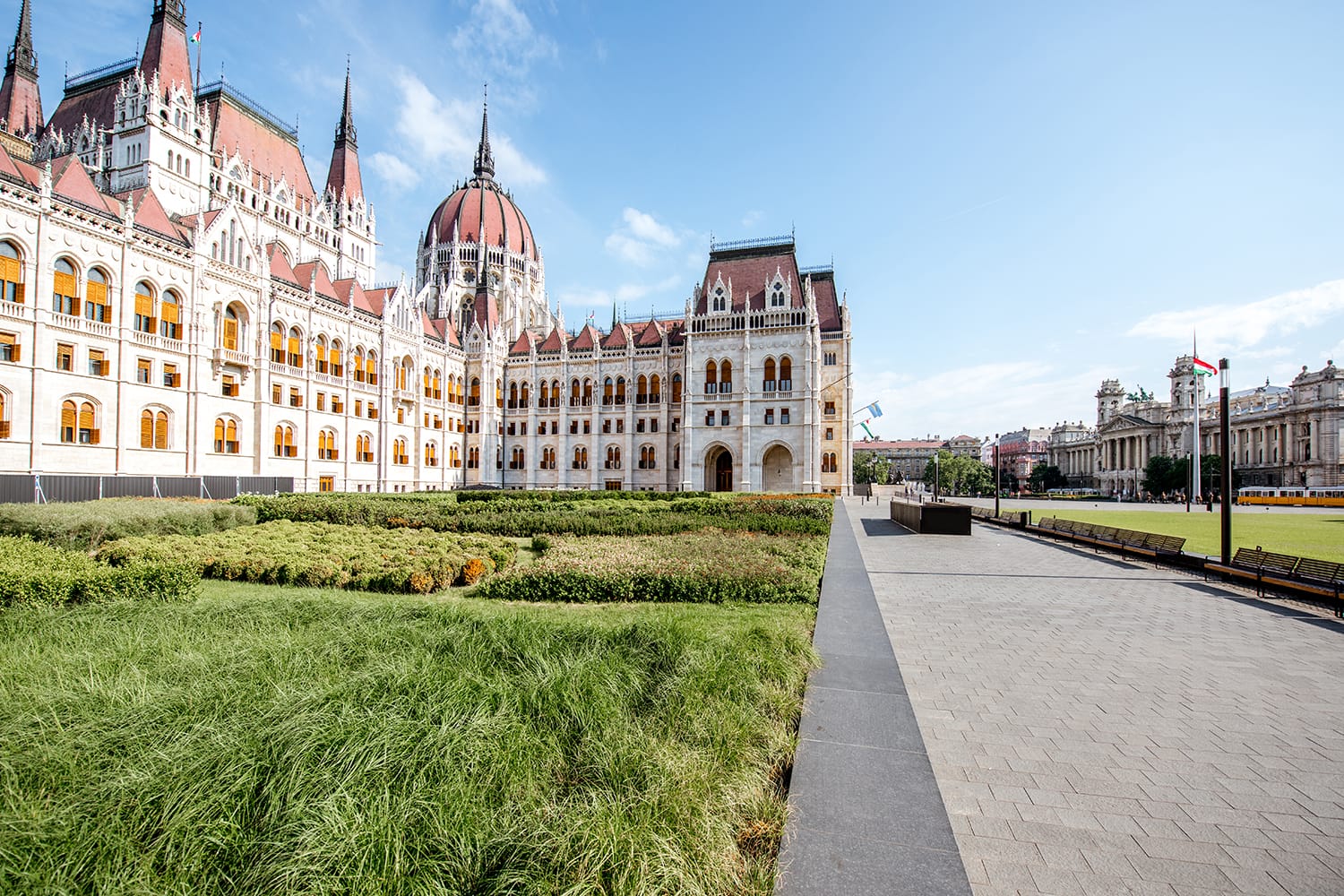
Ruin Bars
Having spent the day busily sightseeing, reward yourself with a few drinks at one of Budapest’s signature ruin bars. Housed inside old and abandoned buildings, each ruin bar in Budapest is different, but they all have plenty of character. With a few days in Budapest, you have the time to try several out and see just how varied they can be. A simple pick to start with is Szimpla, perhaps the most established and best known of Budapest’s semi-underground bar scene.
For something more quiet and romantic, take a night cruise along the Danube river instead. Budapest looks absolutely gorgeous after dark! You can book a night cruise here.
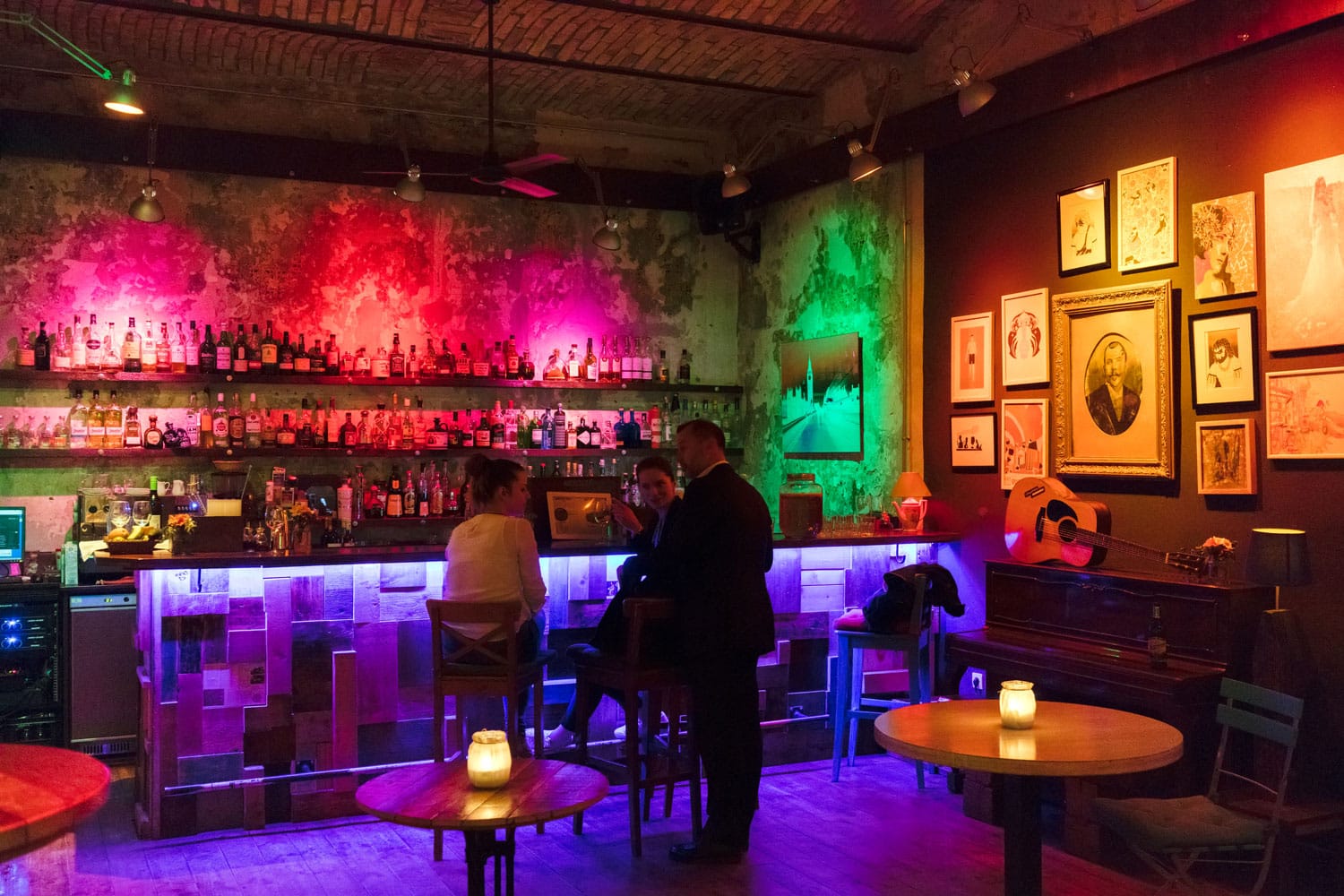
Budapest Itinerary: Day 2
We’ve only just started visiting Budapest, so today it’s all about exploring Pest, which accounts for about two thirds of the city.
St. Stephen’s Basilica
Begin the day with a visit to St. Stephen’s Basilica. This neoclassical building is dedicated to Stephen I, the first king of Hungary and one of the country’s most popular saints. In fact, you can actually see St. Stephen’s mummified right hand in the basilica’s reliquary. Other great experiences that can be had in St. Stephen’s Basilica include climbing the basilica’s dome for some rooftop views and listening to an organ concert inside the church.
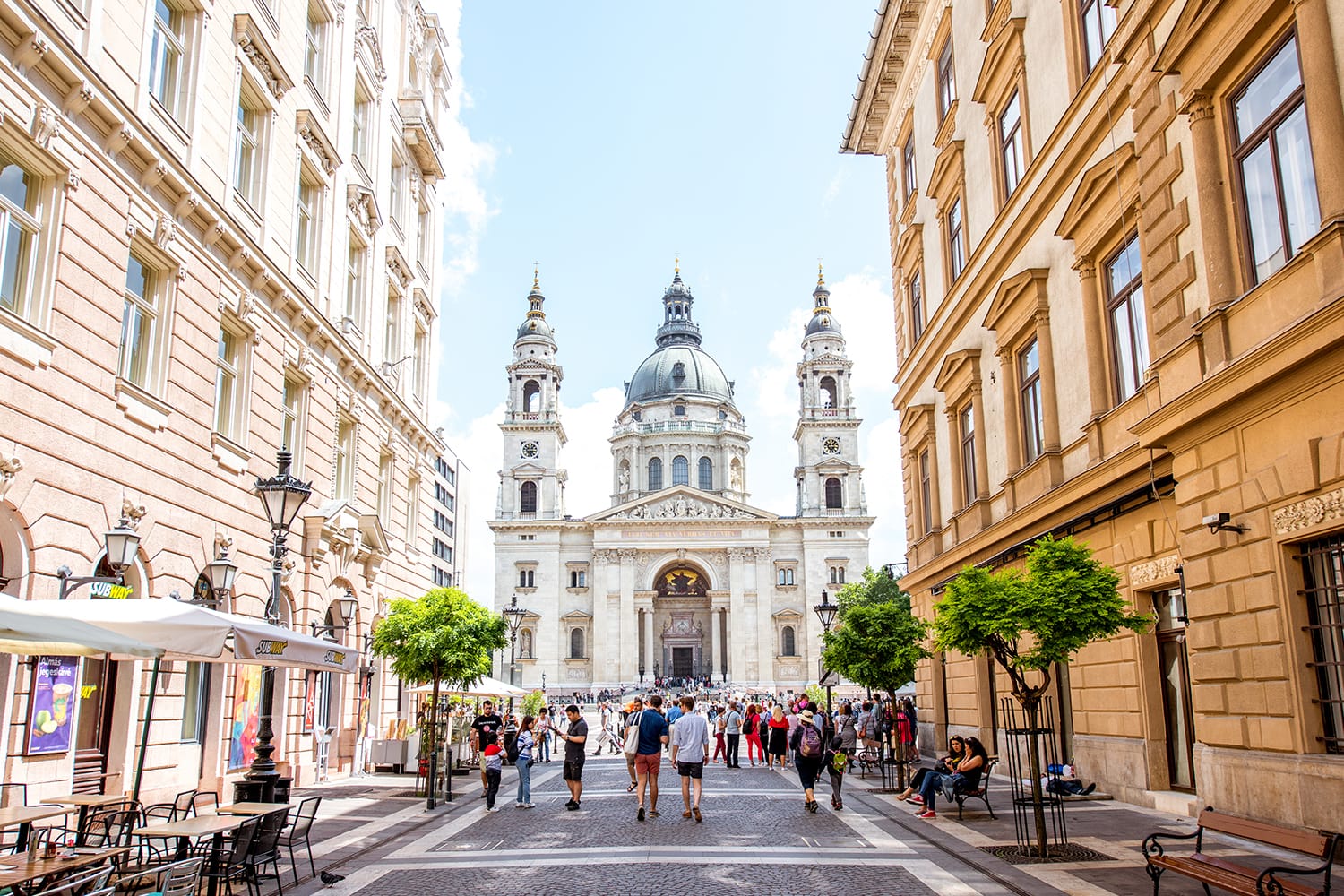
Dohány Street Synagogue
Another impressive place of worship in the heart of Budapest is the Dohány Street Synagogue. Not only is it the largest synagogue in Europe, it also features a stunning Moorish Revival design that’s both unlikely and somehow fitting. Although badly damaged during World War II, the synagogue underwent considerable restoration work in the 1990s. Today it’s more than a practicing synagogue; it also has a memorial and cemetery for the local Jewish community murdered during the Holocaust, as well as a Jewish Museum. You can buy your skip-the-line ticket to the Dohány Street Synagogue here.
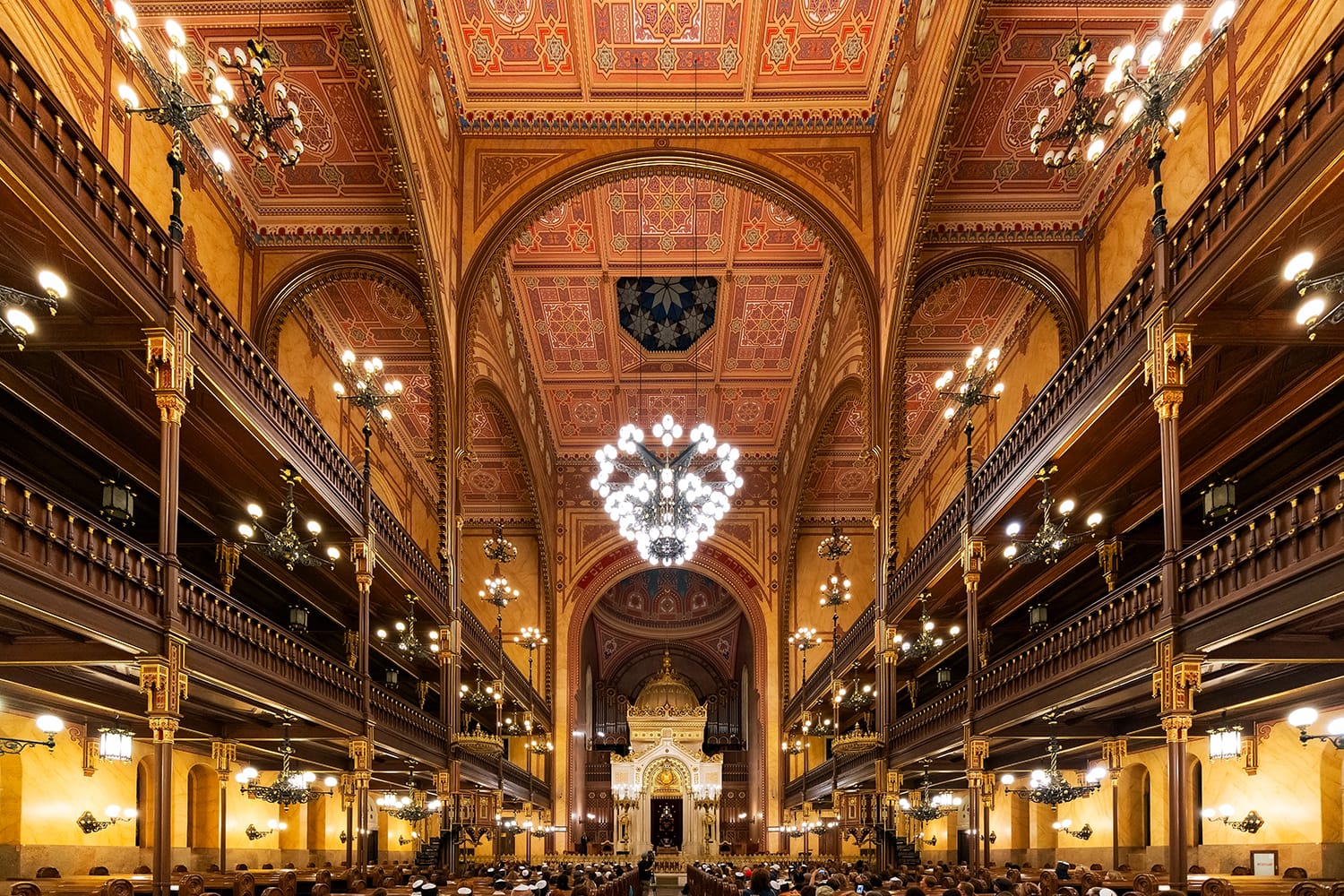
Metro 1
It might seem strange to recommend a metro ride as a don’t-miss activity, but there’s a reason the Metro 1 line is on this Budapest itinerary. Budapest’s Metro 1 is the third oldest underground subway system in the world and is still functioning to this day. Head down into its station at Deák Ferenc tér and take a ride on this subway train heritage-listed by UNESCO. Dating from 1896, the small carriages definitely give you a sense of its advanced age. Just mind your fingers with the old doors; they lack any kind of modern safety features.
Heroes Square
Hop off the Metro 1 at Hősök tere, known in English as Heroes Square. This is one of the city’s major squares thanks to its symbolic collection of monuments. Built to honor the thousandth anniversary of the Hungarian state in 1896, the statues either represent national themes or significant figures from Hungarian history.
At the center of the square is a column with the archangel Gabriel holding the Holy Crown of Hungary’s first king, St. Stephen. Surrounding its base are the seven chieftains of the Magyars on horseback. Behind the column are two grand colonnades with more crucial figures from the country’s history.
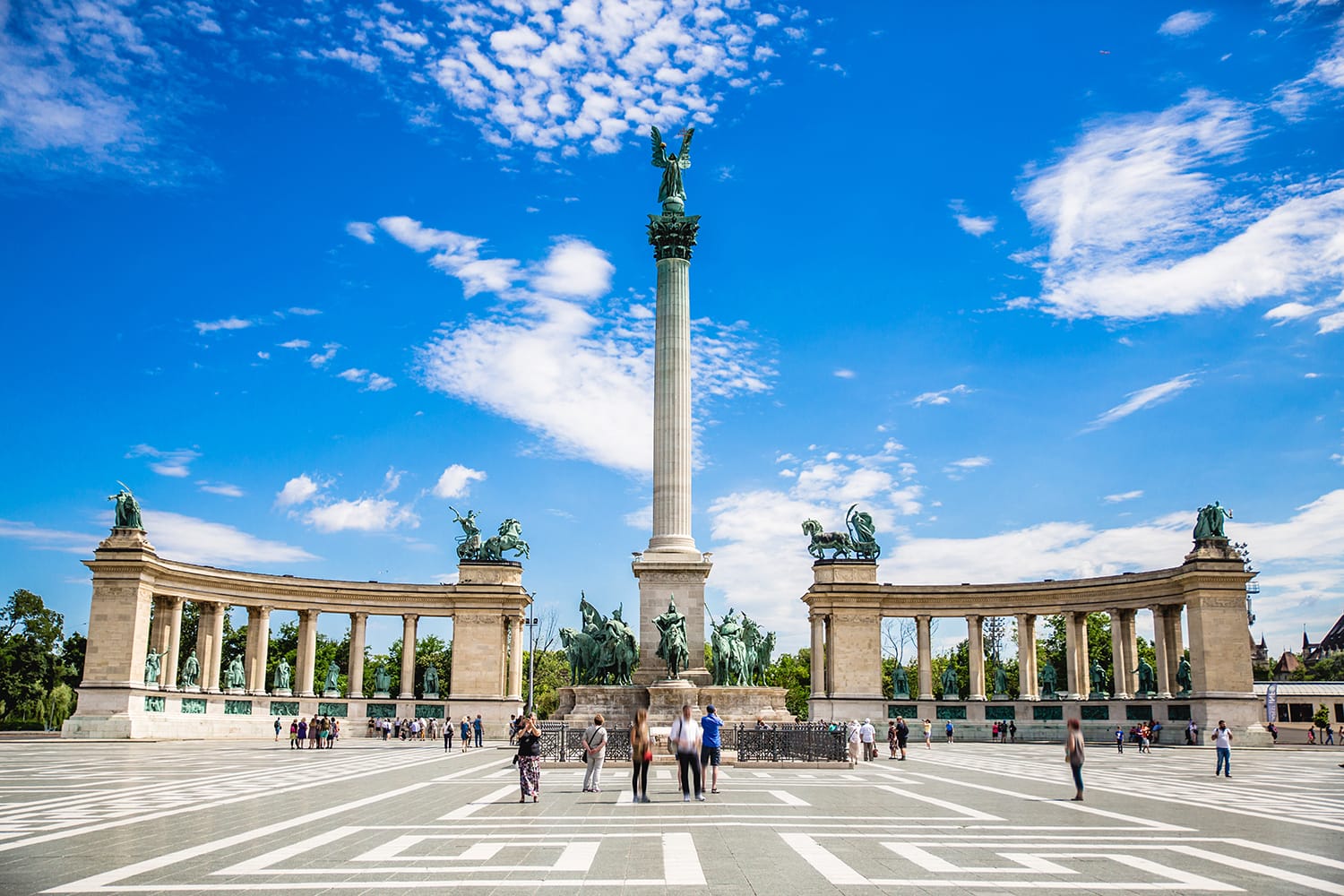
Museum of Fine Arts
On one side of Heroes Square, facing its monuments, you’ll see Budapest’s renowned Museum of Fine Arts. While its neoclassical building makes quite a statement, the real appeal of this museum is, of course, its exceptional collection of foreign art. An entire floor of the museum is dedicated to the Old Masters, with works from Spanish, Flemish, Italian, and other painters. It also showcases sculptures and artifacts from classical Greece, the Etruscans, and the Romans. Topping it all off is the Egyptian collection, which includes ornate sarcophagi and mummy portraits.
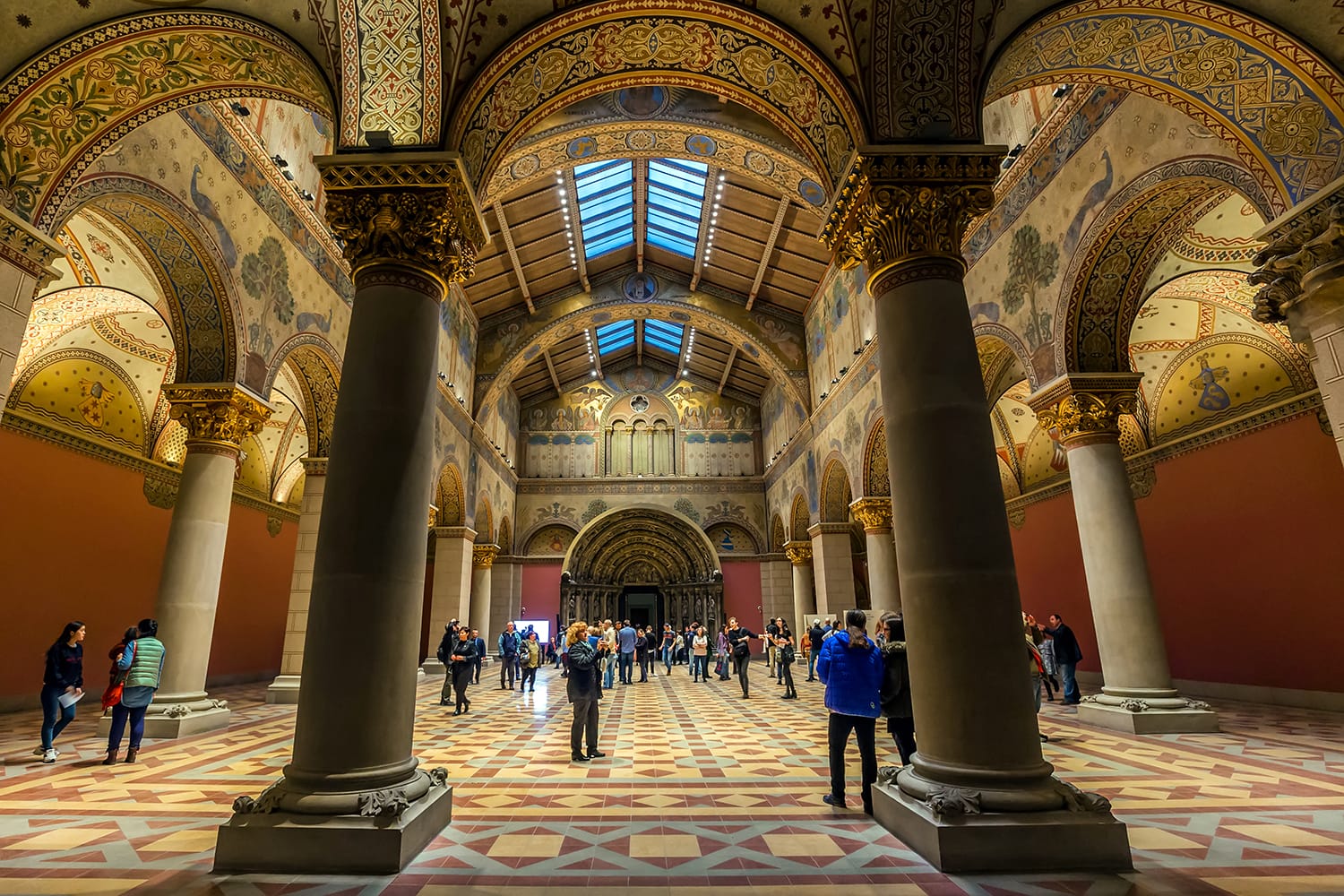
Vajdahunyad Castle
Another spectacular landmark created for the Hungarian millennium festivities, just near Heroes Square, is the romantic Vajdahunyad Castle. Given its old-fashioned and eclectic design, you might not expect this beautiful lakeside castle to only date to 1896. Surrounded by the leafy City Park and a tranquil lake, this may well be Budapest’s most captivating spot. While the Museum of Hungarian Agriculture found inside the castle isn’t much of a reason to visit, you’ll want to walk the castle grounds that look like a scene from Harry Potter.
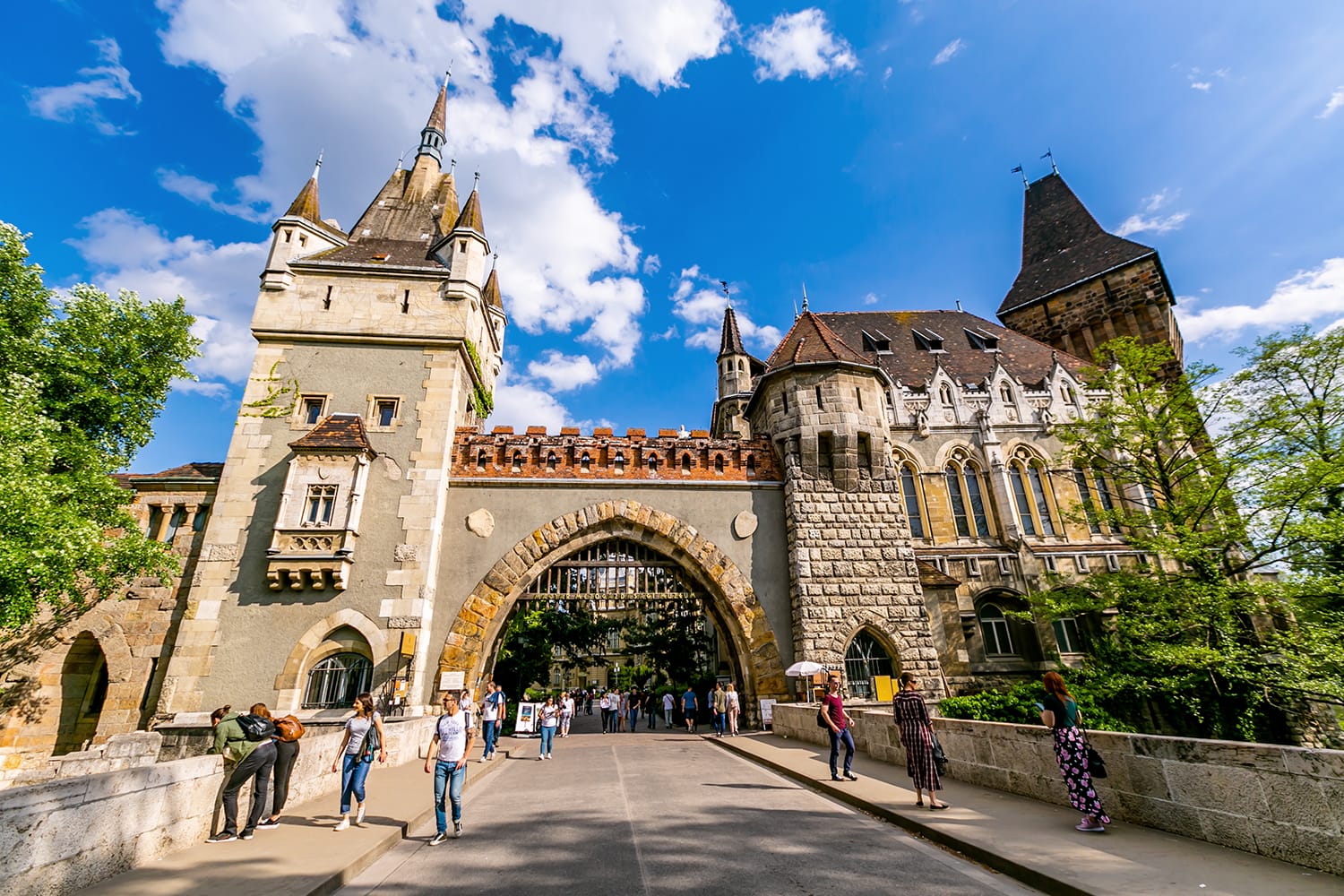
Thermal Baths
The city’s famed thermal baths, one of Budapest’s best activities, are up next. With around 120 hot springs under the city, Budapest is known in some circles as the City of Baths. What could be better after two days of vigorous sightseeing than a leisurely soak in a grand old thermal bath?
Széchenyi Thermal Baths, found not far from Vajdahunyad Castle in City Park, is the city’s most well-known venue and is even known to have spa parties during summer. It’s certainly not alone, though, with one of the other elegant bathhouses being the Gellert Baths by Gellert Hill.
You can buy your skip-the-line ticket for the Széchenyi Thermal Baths here and for the Gellert Spa Baths here.
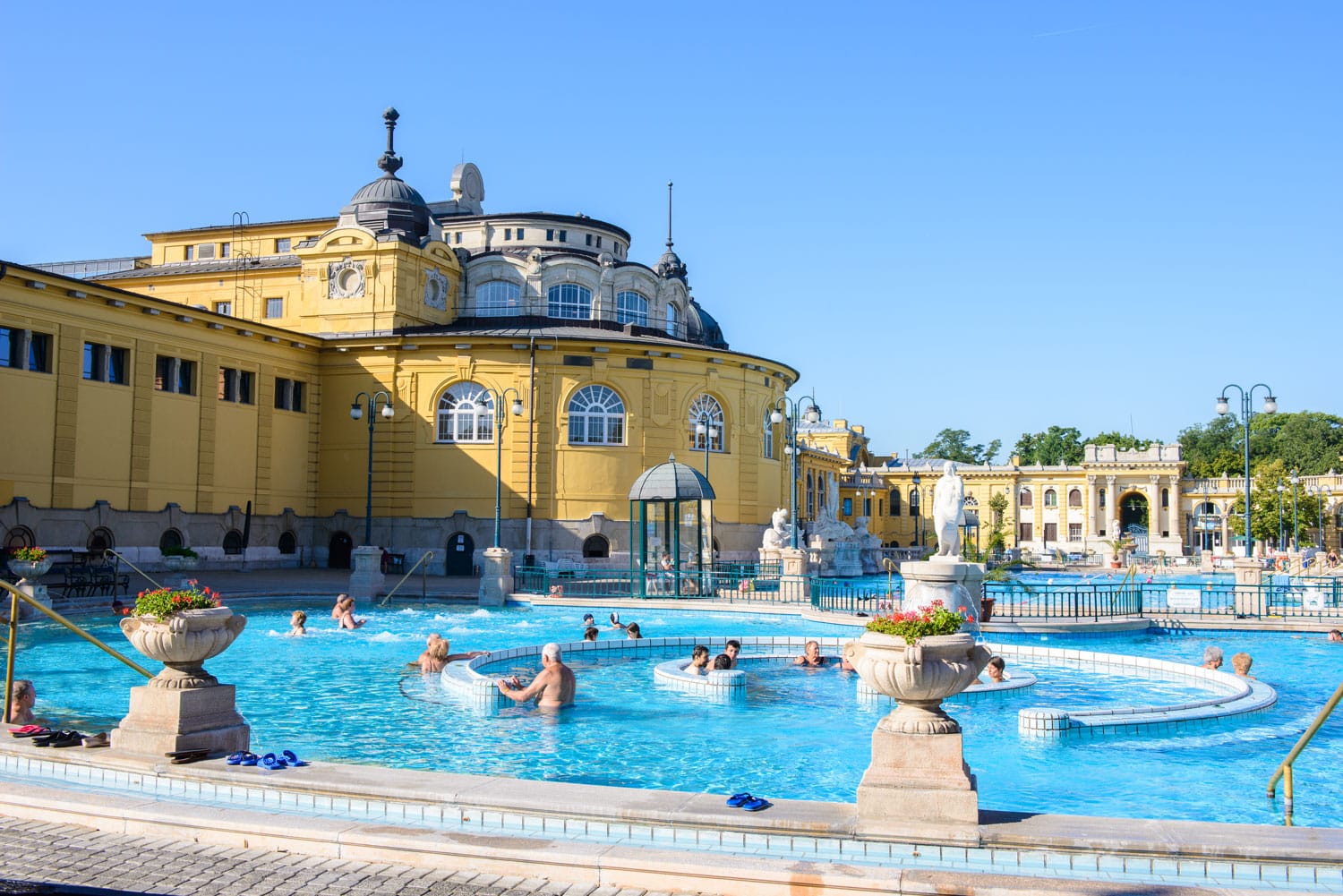
Budapest Itinerary: Day 3
With your 72 hours in Budapest almost up, there’s just enough time to explore beyond the city and see what else Hungary has to offer. Sure, you could find more places in Budapest to visit, but you shouldn’t pass up the opportunity to try one of the many day trips from Budapest.
1. Szentendre
When it comes to places to visit from Budapest, the first destination people turn to is the town of Szentendre. Just up the Danube from Budapest, the creative spirit and pretty architecture of Szentendre have made it one of the most popular day trips from the capital.
Nicknamed the Artists’ Village, Szentendre has been known for its creative community since the start of the 20th century. That bohemian atmosphere is still alive to this day, with many craft shops and galleries scattered throughout the town. Because Szentendre’s quaint cobblestone lanes and vibrant Baroque houses were such an inspiration for the artistic community, very little has changed. Visit today and you’ll immediately feel like you’ve been transported back several centuries as you walk its narrow, picturesque lanes.
The Danube has a way of enhancing the scenery of every destination it passes through, and Szentendre is no exception. So don’t forget to take a walk along the town’s riverfront promenade and see if you too are inspired by this lovely town.
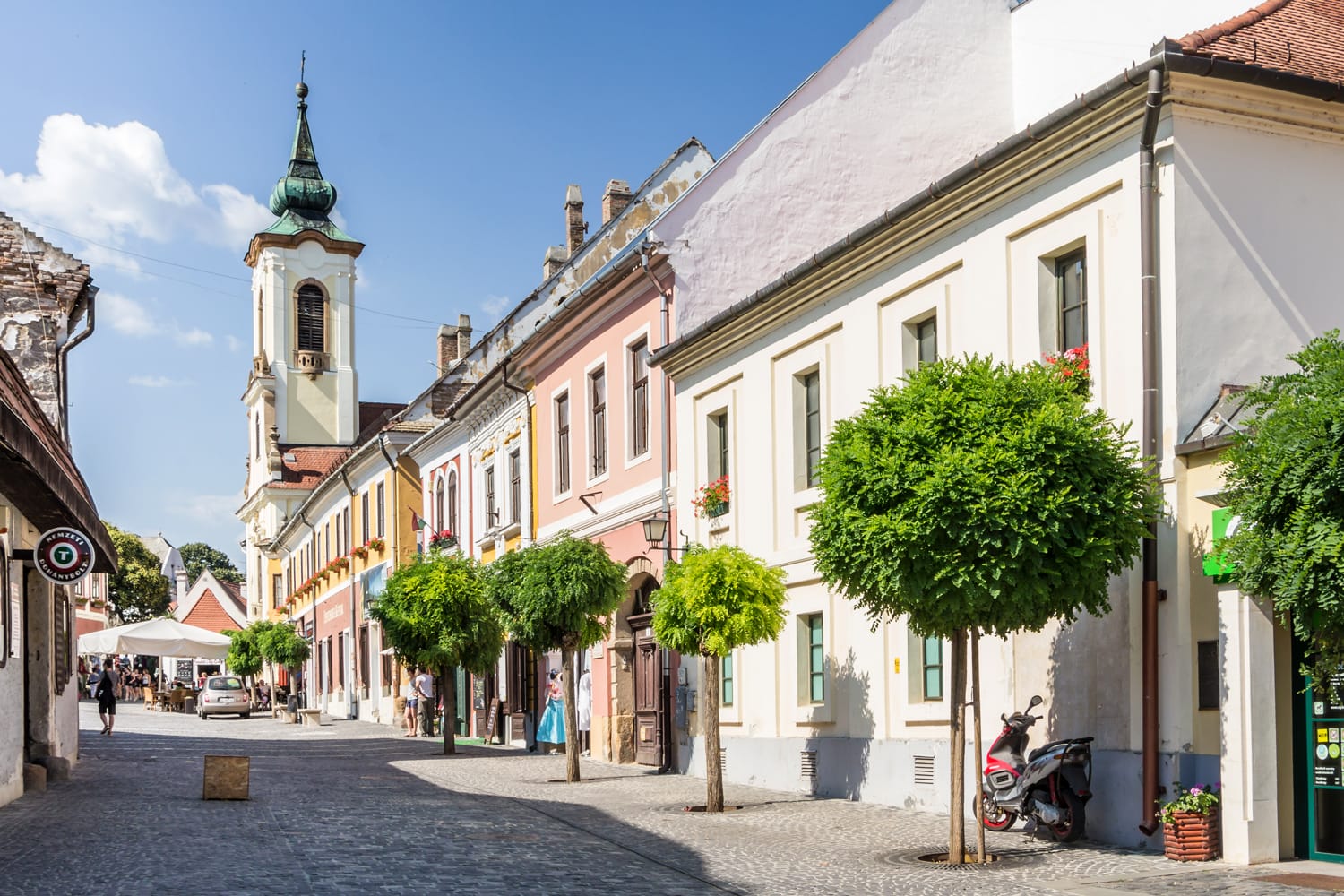
2. Esztergom
One of the oldest cities in Hungary and another scenic place on the Danube River is the delightful city of Esztergom. In fact, Esztergom was the capital of Hungary for a time. Today it’s one of Hungary’s smaller cities, but it’s still quite a gem. Wandering through the city, you’ll find plenty of Baroque, Rococo, and neoclassical buildings, especially in the heart of the city, like in Széchenyi Square.
The big attraction in this riverside city is the gigantic Esztergom Basilica, Hungary’s largest church and tallest building. Sharing the limelight is the 11th-century Esztergom Castle, or what fortifications of it have survived the centuries. The Castle Museum is hosted inside the former Royal Palace, which still stands. There you can visit the castle chapel to see its frescoes from the 12th century and other palace rooms.
Recommendation: To get the most out of your day, consider booking this full-day tour. On this tour, you will not only visit Esztergom and Szentendre but also many other small villages and historic sights in the Danube Valley.
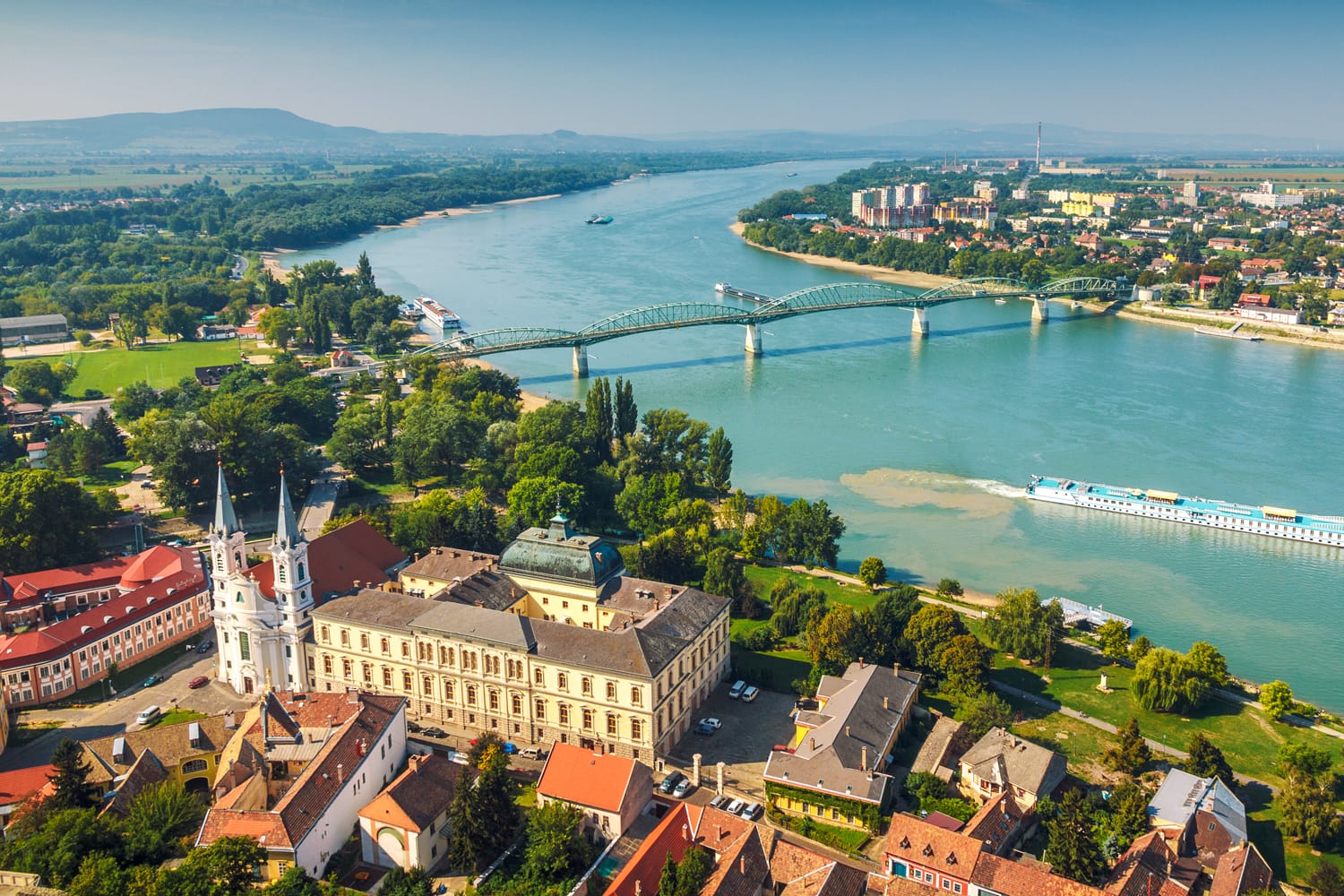
3. Lake Balaton
Hungary may be a landlocked country, but Budapest locals have the next best thing to the seaside thanks to Lake Balaton. Around the shores of Balaton, the largest lake in Central Europe, you’ll find a great selection of resort towns, historical towns, and villages and vineyards. While the area has too much to fit into a single day, here are a few ways to spend your day.
The spa town of Balatonfüred is one of the main points of interest for those visiting from Budapest. Balatonfüred is located on the northern shore of the lake and is known for its thermal spas and avenues lined with grand, old-fashioned villas.
Just down the lake, you’ll find the Tihany Peninsula, most of which is covered in a peaceful nature reserve. The small village of Tihany, where you can visit the historic Tihany Benedictine Abbey, is worth a visit as well. You can also enjoy some great views of Lake Balaton from the abbey thanks to how far the peninsula juts into the lake.
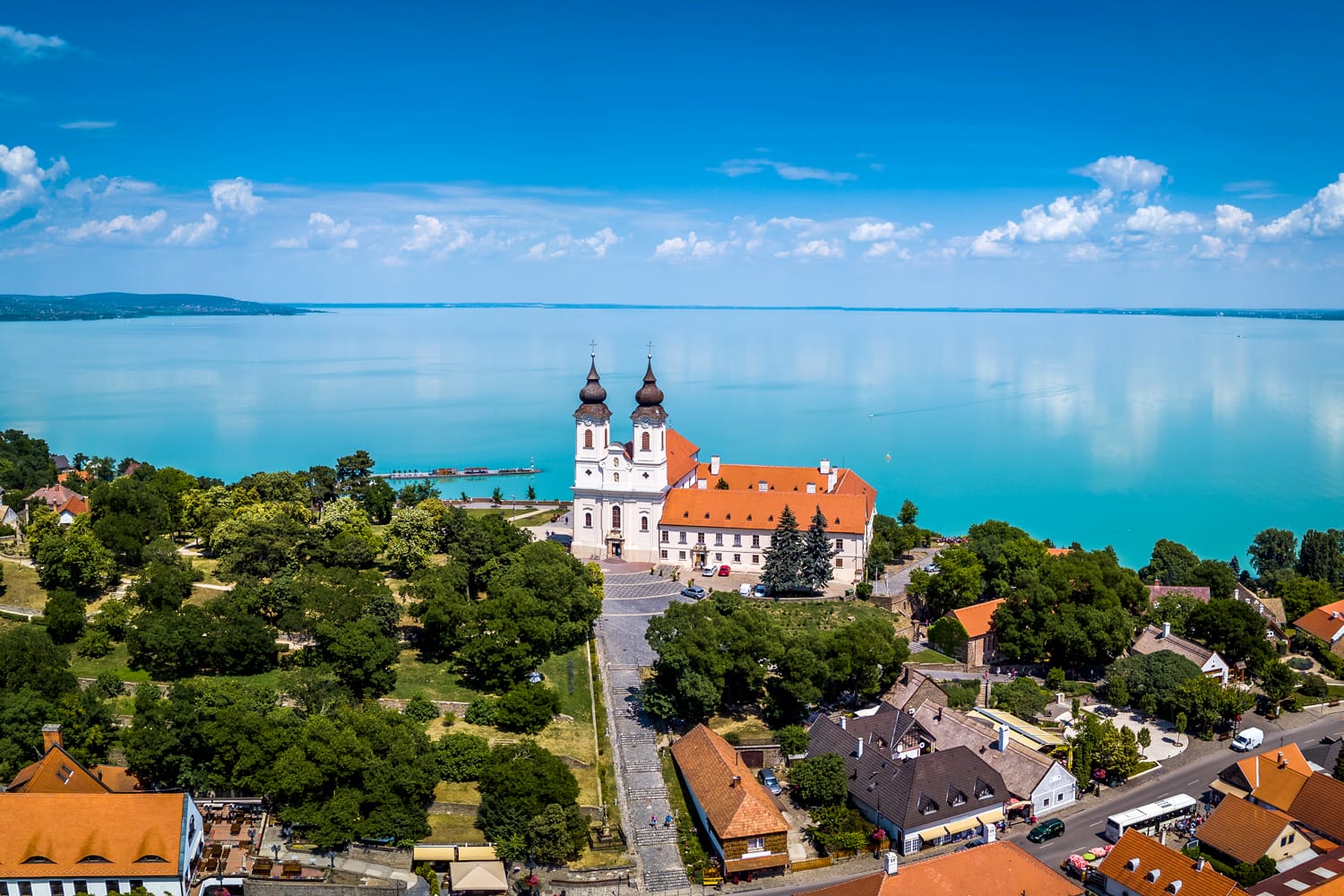
Before you know it, your 3 days in Budapest will be over. It should be clear, though, just how much you can fit into that amount of time. There’s definitely plenty of reason to stay longer, of course. Check out these great day trips from Budapest for other ideas if you have more time.


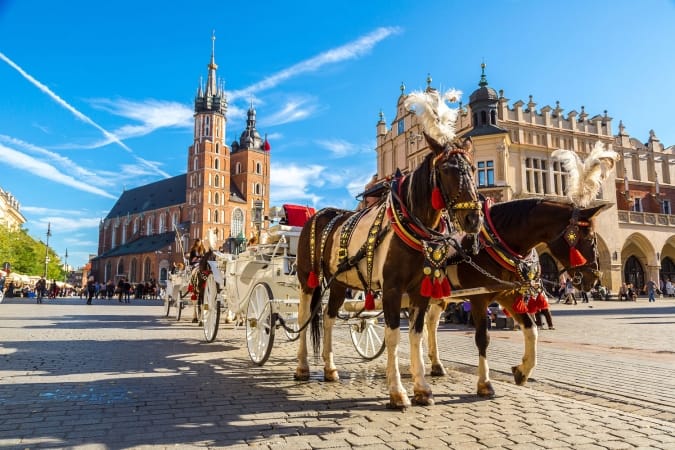
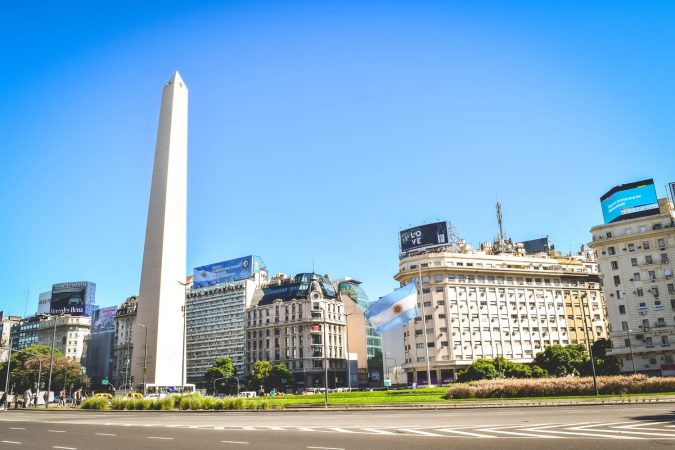

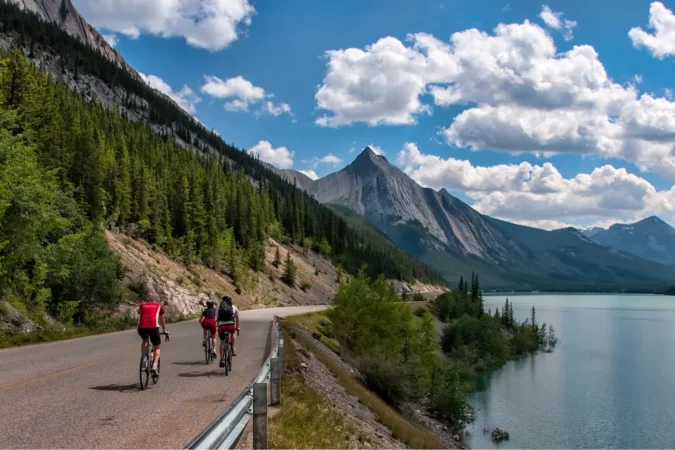

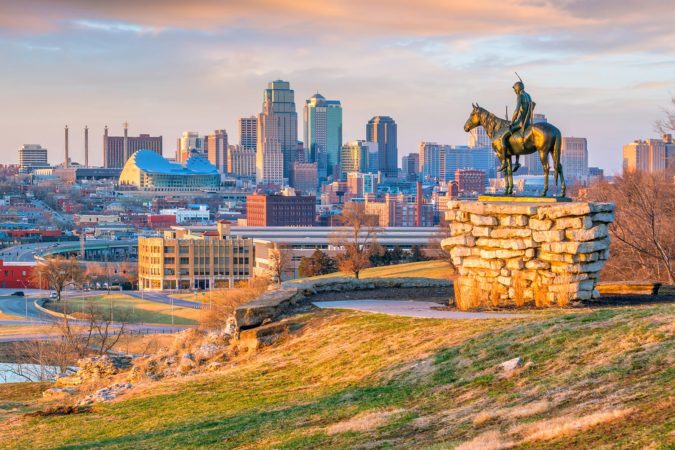
Comments